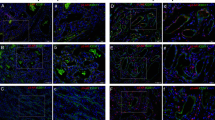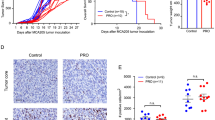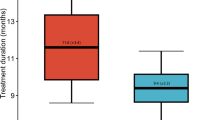Abstract
Background
Propranolol, a non-selective blocker of the β-adrenoceptor (AR), is a first-line treatment for infantile hemangioma (IH). Mast cells have been implicated in the pathophysiology of propranolol-treated hemangioma. However, the function of mast cells remains unclear.
Methods
HMC-1s (Human mast cell line) having been treated with propranolol for 24 h were centrifuged, washed with PBS twice, and maintained in cell culture medium for another 24 h. The supernatants with propranolol which were named as propranolol-treated HMC-1s supernatants were obtained. The expression of cytokines and mediators was examined among HMC-1s dealt with propranolol. HemECs (hemangioma endothelial cells) were co-cultured with propranolol-treated HMC-1s supernatants, and their proliferation and apoptosis were investigated. The autophagic-related protein was examined in HemECs using immunoblot.
Results
In propranolol-treated HMC-1s, the expressions of ADRB1 (β1-AR) and ADRB2 (β2-AR) were reduced by 70% and 60%, respectively, and that of cytokines and mediators were reduced. The proliferation was decreased, but apoptosis and autophagy were induced in HemECs treated with propranolol-treated HMC-1s supernatants. However, propranolol can work well in shRNA-ADRB1 or shRNA-ADRB2 transfected HMC-1s.
Conclusions
Propranolol inhibit the proliferation of HemECs and promote their apoptosis and autophagy through acting on both β1 and β2 adrenoceptor in mast cell.
Impact
-
Treated with propranolol, β1, and β2 adrenoceptor on human mast cell expression was reduced significantly.
-
After hemangioma endothelial cell treated with the supernatants from propranolol-treated human mast cell, its proliferation was decreased, but apoptosis and autophagy were significantly induced.
-
Propranolol can work well in shRNA-ADRB1 or shRNA-ADRB2 transfected HMC-1s. Mast cells may have a role in the action of propranolol in infantile hemangioma through both β1 and β2 adrenoceptors to inhibit the angiogenic capacity of hemangioma endothelial cells.
Similar content being viewed by others
Log in or create a free account to read this content
Gain free access to this article, as well as selected content from this journal and more on nature.com
or
References
Kilcline, C. & Frieden, I. J. Infantile hemangiomas: how common are they? A systematic review of the medical literature. Pediatr. Dermatol. 25, 168–173 (2008).
Holmes, W. J. M., Mishra, A., Gorst, C. & Liew, S. H. Propranolol as first-line treatment for rapidly proliferating Infantile Haemangiomas. J. Plast. Reconstr. Aesthet. Surg. 64, 445–451 (2011).
Leaute-Labreze, C. et al. Propranolol for severe hemangiomas of infancy. N. Engl. J. Med. 358, 2649–2651 (2008).
Ji, Y. et al. Effects of propranolol on the proliferation and apoptosis of hemangioma-derived endothelial cells. J. Pediatr. Surg. 47, 2216–2223 (2012).
Steel, R. & Day, D. Increased apoptosis and secretion of tryptase by mast cells in infantile haemangioma treated with propranolol. Pathology 46, 496–500 (2014).
Prey, S. et al. Mast cells as possible targets of propranolol therapy: an immunohistological study of beta-adrenoceptors in infantile haemangiomas. Histopathology 65, 436–439 (2014).
Norrby, K. Mast cells and angiogenesis. Apmis 110, 355–371 (2002).
Norgall, S. et al. Elevated expression of VEGF-AR-3 in lymphatic endothelial cells from lymphangioms. BMC Cancer 21, 105 (2007).
Lee, D. et al. Propranolol targets the contractility of infantile haemangioma-derived pericytes. Br. J. Dermatol. 171, 1129–1137 (2014).
Chim, H. et al. Propranolol induces regression of hemangioma cells through HIF-1α-mediated inhibition of VEGF-A. Ann. Surg. 256, 146–156 (2012).
Edwards, A. K. et al. NOTCH3 regulates stem-to-mural cell differentiation in infantile hemangioma. JCI Insight 2, e93764 (2017).
Tu, J. B. et al. Induction of apoptosis in infantile hemangioma endothelial cells by propranolol. Exp. Ther. Med. 6, 574–578 (2013).
Zou, H. X., Jia, J., Zhang, W. F., Sun, Z. J. & Zhao, Y. F. Propranolol inhibits endothelial progenitor cell homing: a possible treatment mechanism of infantile hemangioma. Cardiovasc. Pathol. 22, 203–210 (2013).
Itinteang, T. et al. Mast cells ininfantile haemangioma possess a primitive myeloid phenotype. J. Clin. Pathol. 66, 597–600 (2013).
Tan, E. M. et al. Characterisation of subpopulations of myeloid cells in infantile haemangioma. J. Clin. Pathol. 68, 571–574 (2015).
Itinteang, T., Withers, A. H., Davis, P. F. & Tan, S. T. Biology of infantile hemangioma. Front. Surg. 1, 38 (2014).
Greenberger, S. & Bischoff, J. Pathogenesis of infantile haemangioma. Brit. J. Dermatol 169, 12–19 (2013).
Liekens, S., De Clercq, E. & Neyts, J. Angiogenesis: regulators and clinical applications. Biochem. Pharmacol. 61, 253–270 (2001).
Greenberger, S., Boscolo, E., Adini, I., Mulliken, J. B. & Bischoff, J. Corticosteroid suppression of VEGF-A in infantile hemangioma-derived stem cells. N. Engl. J. Med. 362, 1005–1013 (2010).
Park, M. et al. Serum cytokine profiles in infants with infantile hemagimomas on oral propranolol treatment: VEGF-A and bFGF, potential biomarkers predicting clinical outcomes. Pediatr. Res. 88, 749–755 (2020).
Kessenbrock, K., Plaks, V. & Werb, Z. Matrix metalloproteinases: regulators of the tumor microenvironment. Cell 141, 52–67 (2010).
Kleinman, M. E. et al. Hypoxia-induced mediators of stem/progenitor cell trafficking are increased in children with hemangioma. Arterioscler. Thromb. Vasc. Biol. 27, 2664–2670 (2007).
Zhong, S., Yang, G. H., Xia, C., Zhang, D. L. & Shan, S. G. Expression of matrix metalloproteinase and its tissue inhibitor in haemangioma. J. Huazhong. U. Sci. Med 29, 614–619 (2009).
Ji, Y., Chen, S., Xu, C., Li, L. & Xiang, B. The use of propranolol in the treatment of infantile haemangiomas: an update on potential mechanisms of action. Br. J. Dermatol. 172, 24–32 (2015).
Tan, S. T., Wallis, R. A., He, Y. & Davis, P. F. Mast cells and hemangioma. Plast. Reconstr. Surg. 113, 999–1011 (2004).
Qu, Z. H. et al. Mast-cells are a major source of basic fibroblast growth-factor in chronic inflammation and cutaneous hemangioma. Am. J. Pathol. 147, 564–573 (1995).
Takahashi, K. et al. Cellular markers that distinguish the phases of hemangioma during infancy and childhood. J. Clin. Invest. 93, 2357–2364 (1994).
Chang, J. et al. Proliferative hemangiomas: analysis of cytokine gene expression and angiogenesis. Plast. Reconstr. Surg. 103, 1–9 (1999).
Yin, R. R., Hao, D. & Chen, P. Expression and correlation of MMP-9, VEGF-A, and p16 in infantile hemangioma. Eur. Rev. Med. Pharmacol. Sci. 22, 4806–4811 (2018).
Marler, J. J. et al. Increased expression of urinary matrix metalloproteinases parallels the extent and activity of vascular anomalies. Pediatrics 116, 38–45 (2005).
Rotter, A. et al. Evaluation of plasma and urinary levels of vascular endothelial growth factor and matrix metalloproteinase-9 in patients with infantile hemangioma. Int. J. Dermatol. 6, https://doi.org/10.1111/ijd.15640 (2021).
Acknowledgements
We thank Bo Fang, Ph.D. for technical assistance. We also thank H. Nikki March, Ph.D., for editing the English text of a draft of this manuscript.
Author information
Authors and Affiliations
Contributions
Y.Y. and L.W. designed the study. H.Z., Y.Y., and L.D. performed the research and wrote the paper. H.Z. and L.D. analyzed the data. W.S., C.D., and J.L. collected clinical samples and data. W.L. assisted in clinical data collection. L.H. and W.G. assisted in subject enrollment. C.X., G.D., and K.L. offered technical assistance and helped to design the study. L.W. financially supported and revised the paper.
Corresponding author
Ethics declarations
Funding
This work was supported by a Natural Science Foundation of Shanghai grant (No. 16ZR1403900).
Competing interests
The authors declare no competing interests.
Ethical approval
The study was approved by the Ethics Committee of Children’s Hospital of Fudan University. Written informed parental consent was obtained at enrollment.
Additional information
Publisher’s note Springer Nature remains neutral with regard to jurisdictional claims in published maps and institutional affiliations.
Supplementary information
Rights and permissions
About this article
Cite this article
Ye, Y., Zhong, H., Dou, L. et al. Propranolol inhibits the angiogenic capacity of hemangioma endothelia via blocking β-adrenoceptor in mast cell. Pediatr Res 92, 424–429 (2022). https://doi.org/10.1038/s41390-021-01683-4
Received:
Revised:
Accepted:
Published:
Issue date:
DOI: https://doi.org/10.1038/s41390-021-01683-4
This article is cited by
-
Recent updates in laryngeal hemangioma management: a scoping review
European Archives of Oto-Rhino-Laryngology (2024)



